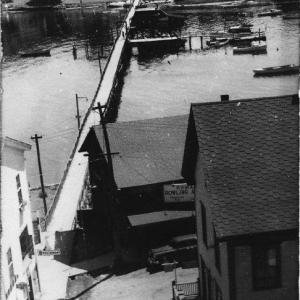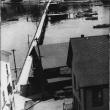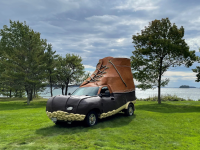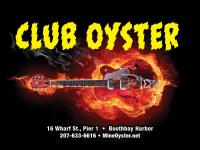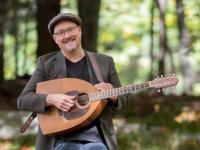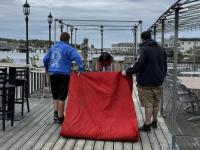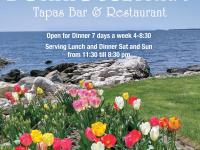The Rowes and the footbridge area
 This mid-1900s shot is taken from the roof of the formerly taller and flat-roofed bank building in Bank Square. It looks east to the Romar Bowling Lanes run by Charlie Rowe, on the right, and the Blue Ship restaurant, run by his wife Kay Marr Rowe, on the left. The Romar name derives from combining Rowe and Marr. Across the footbridge, the little low building is the Bryan Rowe store. There is no good way to get a good view of the foreground buildings on their By-Way locations. Courtesy of Barbara Rumsey
This mid-1900s shot is taken from the roof of the formerly taller and flat-roofed bank building in Bank Square. It looks east to the Romar Bowling Lanes run by Charlie Rowe, on the right, and the Blue Ship restaurant, run by his wife Kay Marr Rowe, on the left. The Romar name derives from combining Rowe and Marr. Across the footbridge, the little low building is the Bryan Rowe store. There is no good way to get a good view of the foreground buildings on their By-Way locations. Courtesy of Barbara Rumsey
 This mid-1900s shot is taken from the roof of the formerly taller and flat-roofed bank building in Bank Square. It looks east to the Romar Bowling Lanes run by Charlie Rowe, on the right, and the Blue Ship restaurant, run by his wife Kay Marr Rowe, on the left. The Romar name derives from combining Rowe and Marr. Across the footbridge, the little low building is the Bryan Rowe store. There is no good way to get a good view of the foreground buildings on their By-Way locations. Courtesy of Barbara Rumsey
This mid-1900s shot is taken from the roof of the formerly taller and flat-roofed bank building in Bank Square. It looks east to the Romar Bowling Lanes run by Charlie Rowe, on the right, and the Blue Ship restaurant, run by his wife Kay Marr Rowe, on the left. The Romar name derives from combining Rowe and Marr. Across the footbridge, the little low building is the Bryan Rowe store. There is no good way to get a good view of the foreground buildings on their By-Way locations. Courtesy of Barbara Rumsey
Next week, the Register plans to run an article detailing the project undertaken to improve the entrances to the footbridge. The project was conceived of by the Rowe girls, Sue, Nancy, and Marianne, daughters of Charlie and Kay Rowe.
In this article I'll explain why that general area on both sides of the footbridge is so meaningful to them. A version of this article was included in a much longer talk I gave about the footbridge a couple of weeks ago. Future articles drawn from that talk will cover the footbridge's history in more depth.
Just to set the stage and briefly summarize the footbridge's history, it was built in 1901 with a swing section to allow vessel passage to the businesses north of the footbridge. The bridge house was built by a bridgetender in 1902, but I believe later tenders did not live in it. Evidence of a town-paid tender dries up in the mid-1950s. The bridge has been rebuilt four times, though some might say more if major repairs rise to the level of a rebuild. Currently, the bridge house is for sale by Allan Miller and Pam Burke.
Family businesses
The Rowes are tied to the footbridge by the family businesses near it. The store at the east end was owned by the Rowe girls' grandfather, Bryan Rowe. The store is also for sale by owners Allan Miller and Pam Burke. Bryan's store was the place to go for S.S. Pierce products when I was young. Two doors down, south on Atlantic Avenue, was the Rowe family house, which has been in the extended family of Moores, Marrs, and Rowes for 100 years and continues to stay in the Rowe family.
At the other end of the footbridge and nearly at its entrance was Romar Bowling Lanes on the By-Way, run by Charlie Rowe for 65 years, from 1946 to 2011. I spent many an hour there as a teenager in the 1960s bowling, playing pinball and meeting my friends.
Underneath the alley on the water side, where William Spring's gallery is now, Charlie had a TV sales and repair shop in the early TV years. Later his daughter Sue had a craft shop there, The Country Corner.
Directly north across from the bowling alley was the Blue Ship, now Andrews' Harborside, on the other side of the footbridge entrance. It was run by Charlie's wife, Kay Marr Rowe, from 1964 to 1976. The Blue Ship, open 11 to 8, was the destination for lunch, the favorite restaurant of my mother and her friends.
Working for family
All three Rowe girls worked in all three family businesses. Charlie would call home from the alley and say, "Need one." That meant one of the girls should run west across the footbridge to man the bowling alley while he ran east across it, home to eat.
Nancy, when needed, drove her grandfather Bryan and sometimes his friends for various errands and favors. And she delivered groceries by car for the Rowe store on the east side while in high school; her lack of a driver's license was not an impediment when the customer came first and needed that food, and she could see over the steering wheel.
The girls also worked at the Blue Ship, where there were lines to get in at lunch time. Sue started when she was 13. When Nancy was 10, she wasn't quite tall enough to reach the coffee machine; she thought she had her ticket to get out of working there and looked forward to focusing on golf that summer.
However, a platform magically appeared so she could reach the coffee, and she was sentenced to the restaurant after all. As long as their parents had those businesses, particularly the alley, the girls, all teachers, would return in the summer to help out. Maybe they got some golf in too!
More family businesses
Remembering this is small-town life, not only did the girls' mother, father and grandfather run businesses right near home, they were related to others running businesses nearby. West across from the bowling alley was Charlie's sister in her beauty salon, where the Harold Bishop agency is now.
Kay's mother, Bea Marr, had a restaurant just a door or two south from the bowling alley on the By-Way. Sue Rowe married Charlie Anderson of Anderson & Gaw at the old grain mill, just north of the footbridge. It is now the Chowder House.
Leon Tibbetts, who ran the Broken Anchor just north of the grain mill was a first cousin to Charlie Rowe. As you can see, the vicinity was one big, hard-working, extended family, and the footbridge was their backyard.
The harbor is lucky to have these public-spirited girls take on this project to improve a part of the town that has been central to their lives, their parents' lives, and their grandparents' lives, the footbridge a constant always in their line of sight.
Event Date
Address
United States

